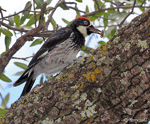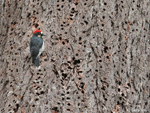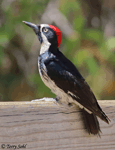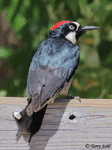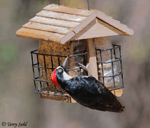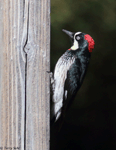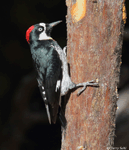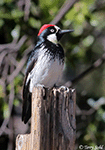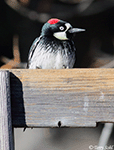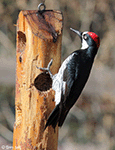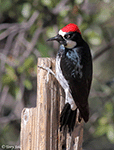| Length: 9 inches | Wingspan: 17.5 inches | Seasonality: Non-resident in South Dakota |
| ID Keys: Red cap, unique black-and-cream facial pattern, dark upperparts, light underparts | ||
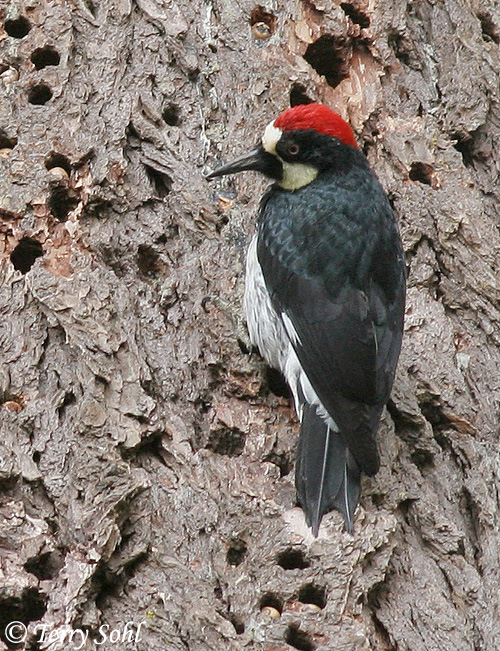 Acorn
Woodpeckers are an unusual woodpecker of the western U.S. and Mexico with a
unique and complex social structure. The species is best known for
their "granary trees", trees which typically have many hundreds to many
thousands of holes drilled into them for the storage of acorns or other nuts
(note photo to the right of a male Acorn Woodpecker, on a granary tree in
coastal California). Acorns are gathered in abundance in the fall and
placed in the granary tree holes for consumption during the leaner winter
months. Gregarious in all seasons, small colonies of Acorn Woodpeckers
will vigorously defend the granary tree from other Acorn Woodpeckers and
from other birds attempting to use the resource. The species is just
as gregarious during the summer breeding season, when all members of the
colony will participate in nest construction, incubation of the eggs, and
raising of the young.
Acorn
Woodpeckers are an unusual woodpecker of the western U.S. and Mexico with a
unique and complex social structure. The species is best known for
their "granary trees", trees which typically have many hundreds to many
thousands of holes drilled into them for the storage of acorns or other nuts
(note photo to the right of a male Acorn Woodpecker, on a granary tree in
coastal California). Acorns are gathered in abundance in the fall and
placed in the granary tree holes for consumption during the leaner winter
months. Gregarious in all seasons, small colonies of Acorn Woodpeckers
will vigorously defend the granary tree from other Acorn Woodpeckers and
from other birds attempting to use the resource. The species is just
as gregarious during the summer breeding season, when all members of the
colony will participate in nest construction, incubation of the eggs, and
raising of the young.
Habitat: Acorn Woodpeckers are nearly always found near oak trees. They are most common in areas with multiple species of oaks, a habitat choice which guards against acorn crop failure for any one particular oak species in a given year.
Diet: Acorns make up a large part of the diet, especially during the winter months. Insects are also heavily fed upon, and Acorn Woodpeckers particularly like to feed on ants and flying ants. Other food items include fruits, berries, seeds, and tree sap.
Behavior: Gregarious in all seasons, both during the breeding season, and when feeding and foraging outside of the breeding season.
Nesting: Nesting of Acorn Woodpeckers is a communal activity, with nesting colonies typically consisting of between 1 to 8 breeding males and 1 to 3 breeding females, with nonbreeding adults also helping to raise young. The nest is a tree cavity, nearly always in a dead tree or tree branch, with multiple members of the breeding colony helping to excavate the nest hole. Multiple females may lay eggs in the communal nest, and multiple birds in the community will help incubate the eggs. All members of the nesting colony help to feed and raise the young.
Interactive eBird Map: Click to access an interactive eBird map of Acorn Woodpecker sightings.
Song: Acorn Woodpeckers are very vocal, with a variety of calls.
Migration: Acorn Woodpeckers are considered permanent residents throughout their range. However, in years with poor acorn crops, numbers may disperse to nearby locations. Individual birds have also been known to wander widely, as vagrants have appeared in many unexpected locations across the United States.
Feeders: Will occasionally attend feeders for nuts, sunflower seeds, and suet.
Similar Species: Distinctive if seen well
Conservation Status: There are currently no perceived major threats to Acorn Woodpecker populations, and Birdlife International cites it as a species of "Least Concern".
Further Information: 1) Audubon Field Guide - Acorn Woodpecker
2) WhatBird - Acorn Woodpecker
3) BirdWeb.org - Acorn Woodpecker
Photo Information: April 19th, 2007 - Point Reyes National Seashore, California - Terry Sohl
| Click below for a higher-resolution map |
 |
| South Dakota Status: Non-resident in South Dakota |
Additional Acorn Woodpecker Photos
Click for a higher-resolution version of these photos
